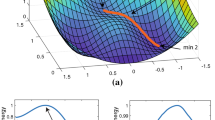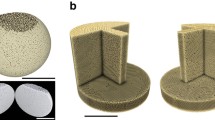Abstract
Granular materials represent a vast category of particle conglomerates with many areas of industrial applications. Here we represent these materials by graphs which capture their topological organization and ordering. Then, using the communicability function—a topological descriptor representing the thermal Green function of a network of harmonic oscillators—we prove the existence of a universal topological melting transition in these graphs. This transition resembles the melting process occurring in solids. We show here that crystalline-like granular materials melts at lower temperatures and display a sharper transition between solid to liquid phases than the random spatial graphs, which represent amorphous granular materials. In addition, we show the evolution mechanism of melting in these granular materials. In the particular case of crystalline materials the process starts by melting a central core of the crystal which then growth until the whole material is in the liquid phase. We provide experimental confirmation from published literature about this process.








Similar content being viewed by others
References
S. Alexander, Amorphous solids: their structure, lattice dynamics and elasticity. Phys. Rep. 296, 65–236 (1998)
V. Alexiades, Mathematical Modeling of Melting and Freezing Processes (CRC Press, Boca Raton, 1992)
R. Bandyopadhyay, D. Liang, J.L. Harden, R.L. Leheny, Slow dynamics, aging, and glassy rheology in soft and living matter. Solid State Commun. 139, 589–598 (2006)
J. Borge-Holthoefer, Y. Moreno, A. Arenas, Modeling abnormal priming in Alzheimer’s patients with a free association network. PLoS ONE 6, e22651 (2011)
R.W. Cahn, Melting and the surface. Nature 323, 668–669 (1986)
S.N. Dorogovtsev, A.V. Goltsev, J.F. Mendes, Critical phenomena in complex networks. Rev. Modern Phys. 80, 1275 (2008)
E. Estrada, The Structure of Complex Networks: Theory and Applications (Oxford University Press, Oxford!, 2012)
E. Estrada, N. Hatano, Statistical-mechanical approach to subgraph centrality in complex networks. Chem. Phys. Lett. 439, 247–251 (2007)
E. Estrada, N. Hatano, Communicability in complex networks. Phys. Rev. E 77, 036111 (2008)
E. Estrada, N. Hatano, M. Benzi, The physics of communicability in complex networks. Phys. Rep. 514, 89–119 (2012)
E. Estrada, D.J. Higham, Network properties revealed through matrix functions. SIAM Rev. 52, 696–714 (2010)
K.R. Gabriel, R.R. Sokal, A new statistical approach to geographic variation analysis. Syst. Biol. 18, 259–278 (1969)
M. Hiraiwa, M.A. Ghanem, S.P. Wallen, A. Khanolkar, A.A. Maznev, N. Boechler, Complex contact-based dynamics of microsphere monolayers revealed by resonant attenuation of surface acoustic waves. Phys. Rev. Lett. 116, 198001 (2016)
Z. Jin, P. Gumbsch, K. Lu, E. Ma, Melting mechanisms at the limit of superheating. Phys. Rev. Lett. 87, 055703 (2001)
F.A. Lindemann, The calculation of molecular eigen-frequencies. Phys. Z. (West Germany) 11, 609–612 (1910)
Y.-Y. Liu, E. Csóka, H. Zhou, M. Pósfai, Core percolation on complex networks. Phys. Rev. Lett. 109, 205703 (2012)
M.Z. Miskin, H.M. Jaeger, Adapting granular materials through artificial evolution. Nat. Mater. 12, 326 (2013)
J. Nagler, T. Tiessen, H.W. Gutch, Continuous percolation with discontinuities. Phys. Rev. X 2, 031009 (2012)
L. Papadopoulos, M.A. Porter, K.E. Daniels, D.S. Bassett, Network analysis of particles and grains. J. Complex Net. 6, 485–565 (2018)
S.R. Phillpot, S. Yip, D. Wolf, How do crystals melt? Comput. Phys. 3, 20–31 (1989)
M.A. Porter, P.G. Kevrekidis, C. Daraio, Granular crystals: nonlinear dynamics meets materials engineering. Phys. Today 68, 44–50 (2015)
D.L. Powers, Graph partitioning by eigenvectors. Linear Algebra Its Appl. 101, 121–133 (1988)
B. Rudra, Y. Jiang, Y. Li, J. Shim, A class of diatomic 2-d soft granular crystals undergoing pattern transformations. Soft Matter 13, 5824–5831 (2017)
J.H. Smith, Some properties of the spectrum of a graph, in Combinatorial Structures and their Applications, eds. by R. Guy, H. Hanani, N. Sauer, J. Schonhcim (Gordon and Breach, New York, 1970), pp. 403–406
J.C. Urschel, L.T. Zikatanov, Spectral bisection of graphs and connectedness. Linear Algebra Its Appl. 449, 1–16 (2014)
S.R. Vippagunta, H.G. Brittain, D.J. Grant, Crystalline solids. Adv Drug Deliv. Rev. 48, 3–26 (2001)
D.M. Walker, A. Tordesillas, Topological evolution in dense granular materials: a complex networks perspective. Int. J. Solids Struct. 47, 624–639 (2010)
Z. Wang, F. Wang, Y. Peng, Y. Han, Direct observation of liquid nucleus growth in homogeneous melting of colloidal crystals. Nat. Commun. 6, 6942 (2015)
Acknowledgements
The authors thank Dr. F. Arrigo, and Prof. D. H. Higham for useful comments and suggestions which improve the presentation of the material. NA thanks Iraqi Government for a Doctoral Fellowship at the University of Strathclyde.
Author information
Authors and Affiliations
Corresponding author
Rights and permissions
About this article
Cite this article
Alalwan, N., Arenas, A. & Estrada, E. Topological melting in networks of granular materials. J Math Chem 57, 875–894 (2019). https://doi.org/10.1007/s10910-018-0988-0
Received:
Accepted:
Published:
Issue Date:
DOI: https://doi.org/10.1007/s10910-018-0988-0




